SEO
9 Actionable Tips to Master It
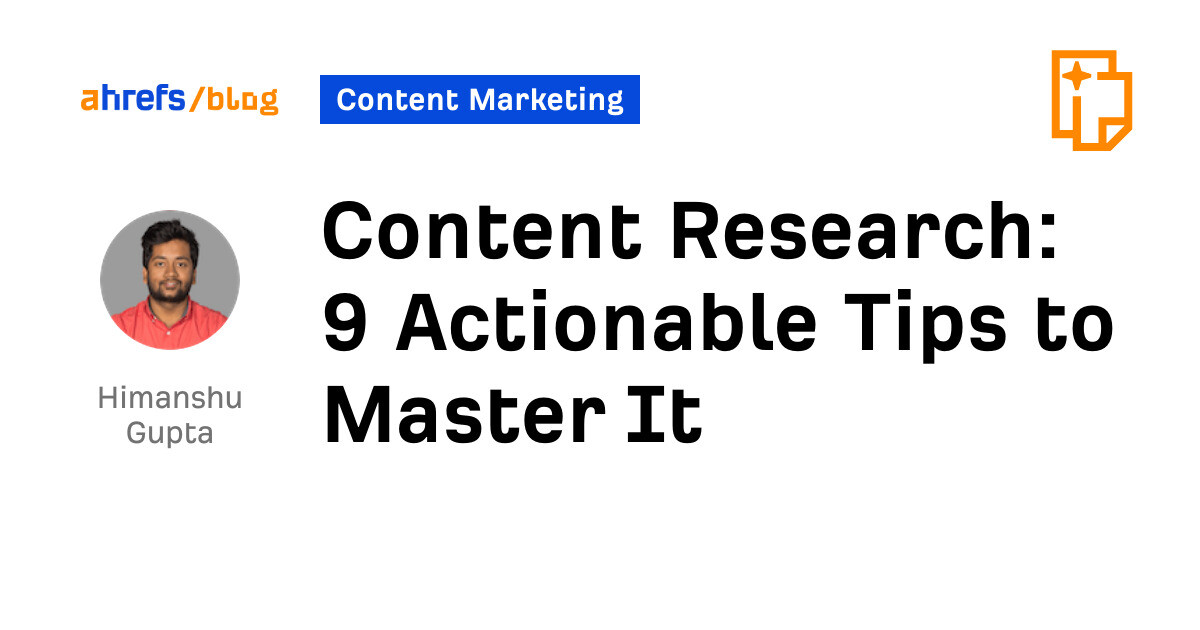
The first step to your content’s success is how much research you put into it.
When I started my career as a writer, I didn’t focus much on content research. My focus was always on completing the first draft as soon as possible.
But with time, I understood the importance of content research and saw a direct impact of it on engagement, traffic, and more. Simply put, researching helped me create great content that readers found immense value from.
Whenever you deep dive into a topic, you discover valuable insights, case studies, and critical information regardless of your expertise. This is crucial to creating a valuable, credible, and actionable article that can achieve its objectives.
Let’s dive into nine actionable content research tips I’ve learned along the way.
You need to choose a topic that helps you achieve a certain goal. For example, your goal with the article might be to:
- Drive organic traffic.
- Increase brand visibility.
- Get social shares.
- Build product awareness.
For this, you need to focus on a topic that your readers will find relevant and gain value from. This is possible when the article focuses on your reader’s current challenges, provides solutions to their problems, and/or shares valuable insights about your niche.
For example, when your goal is to drive organic traffic, the first step should be to find keywords that your audience is searching for. This is known as keyword research.
To begin your keyword research, add a broad term (or terms) characterizing the topic to Ahrefs’ Keywords Explorer. Then click on the Matching terms report to see all keywords containing the terms on the input.
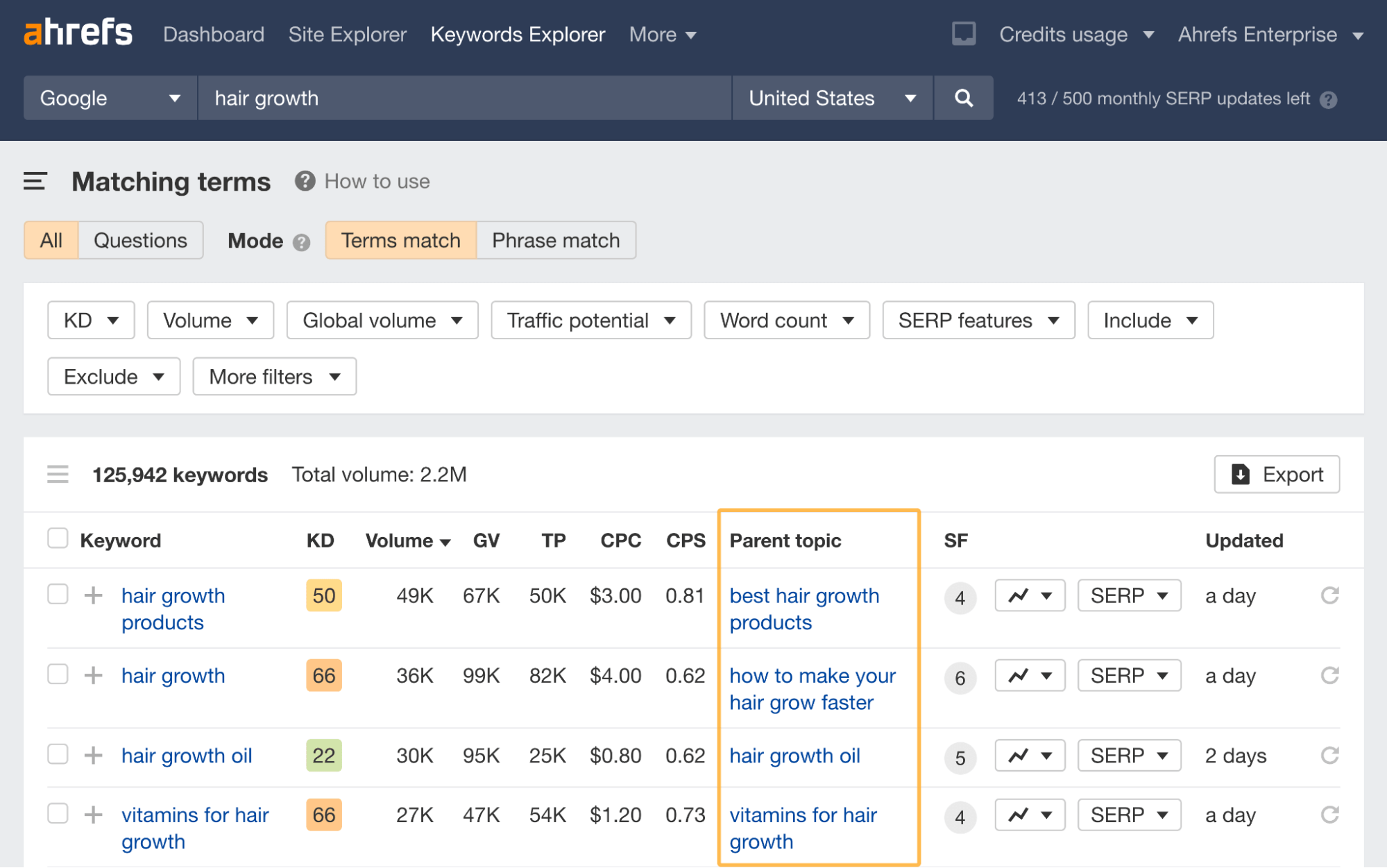
You can filter the keywords based on metrics like Keyword Difficulty, search volume, or Traffic Potential, but that’s for another discussion.
What you want here is to choose your topic from the “Parent topic” column. It shows you the keyword responsible for driving the most traffic to a page ranking at the top for a given keyword. As a rule of thumb, you should choose these as your topic if you want to maximize your organic traffic potential.
Similarly, if you want to achieve buzz on social media, you should analyze currently trending topics or try your best to align with what characterizes viral content.
Regardless of your content goals, you should always understand the search intent behind your topic. It helps you identify:
- How the existing resources cover the topic.
- The gaps and flaws in what’s already published.
- The depth readers are expecting when searching about the topic.
For example, it only makes sense to write a blog post when there’s informational intent for the keyword. Similarly, if it’s transactional, publishing a product page makes more sense.
Here are the three Cs of search intent your content should align with:
- Content type (blog post, landing page, or category page).
- Content format (guide, tutorial, review, or list post).
- Content angle (for beginners, advanced, opinionated post, etc.).
Here, we can see that the right content type for the keyword “how grow a rose from a cutting” is a video:

Then we have the keyword “how to grow hair faster,” where the most relevant content format is a listicle type of post:
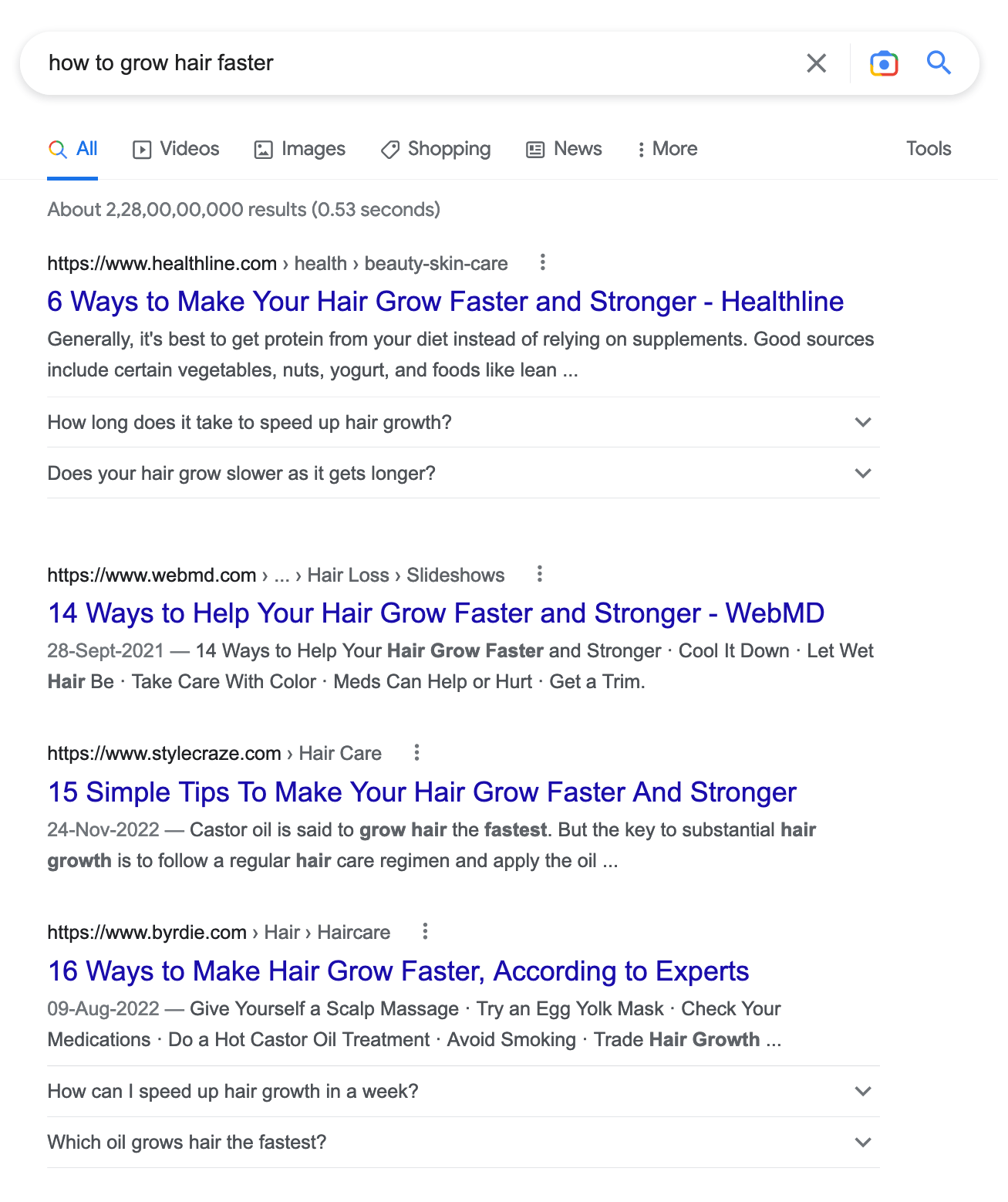
Last but not least, going through the first few search results for a given keyword will help you identify the content angle. For example, for the keyword “apple cider vinegar,” the content angles revolve around either covering just the benefits or pretty much all the health information people could be looking for:

Dive deeper with competitor analysis
Clicking through the top-ranking pages and skimming competing content help us create a better picture of what Google considers as information that people want to see. A few things you should keep in mind when researching your competitors’ articles are:
- Article structure.
- Article depth.
- Unique or interesting insights.
- Usage of infographics, charts, graphs, or other visuals.
Look at the People Also Ask (PAA) box and related searches
Google’s PAA box tells you a lot about what questions readers tend to ask. It’s a good idea to reflect this in your writing.
Here’s an example for the keyword “apple cider vinegar”:
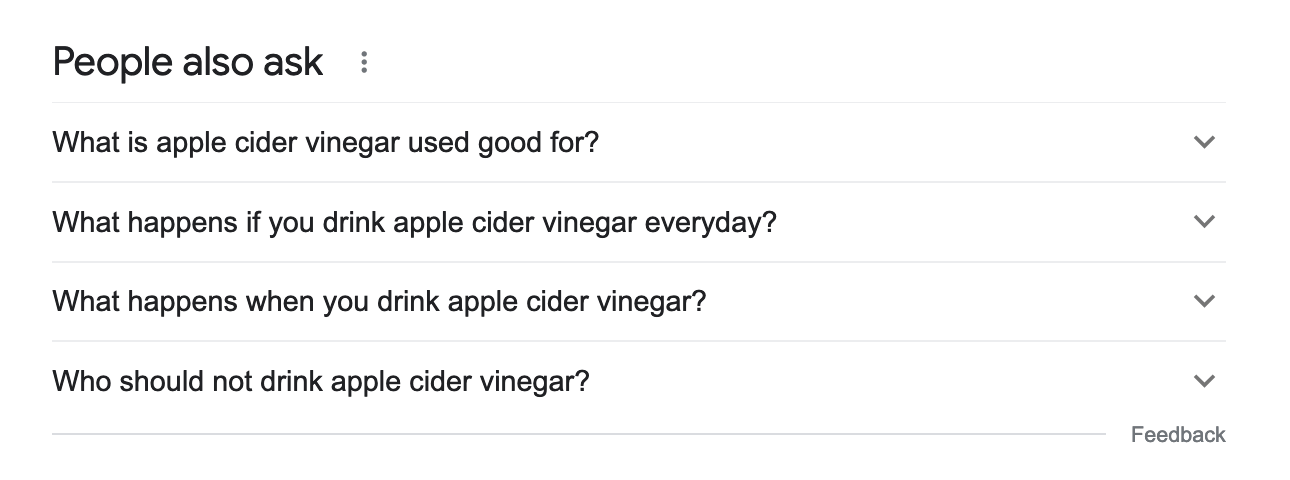
Apart from PAA boxes, you should also analyze related searches that show up at the bottom of the search.

If you want your article to stand out, you need to think out of the box. For this, you need to put yourself in the reader’s shoes and brainstorm on how you can add additional value.
There are many reasons why certain pieces of content succeed, including original research/data, how it has been structured, or how effectively it explains the particular topic. Hence, while researching, you should think about how you can:
- Support your statements with original research.
- Add case studies wherever relevant and if possible.
- Challenging the status quo with your own perspectives.
- Share your personal experience/opinion.
- Add checklists, infographics, flowcharts, or quizzes to make the content more impactful and interactive.
You don’t know every topic equally well even if you have experience in a particular niche. If you lack the expertise, I recommend interviewing subject matter experts (SMEs).
These experts can offer key insights and share information that you likely won’t be able to put together yourself.
But who are SMEs and where can you find them?
SMEs can be someone in your organization, your friend at a different organization, or an influencer in your industry. You can easily find them using platforms like SparkToro and Ahrefs’ Content Explorer.
In SparkToro, you just need to enter a niche keyword to find relevant influencers. You can also filter them on the basis of followers and relevancy. Just be sure to choose the account type as “Individual” to filter out company accounts.
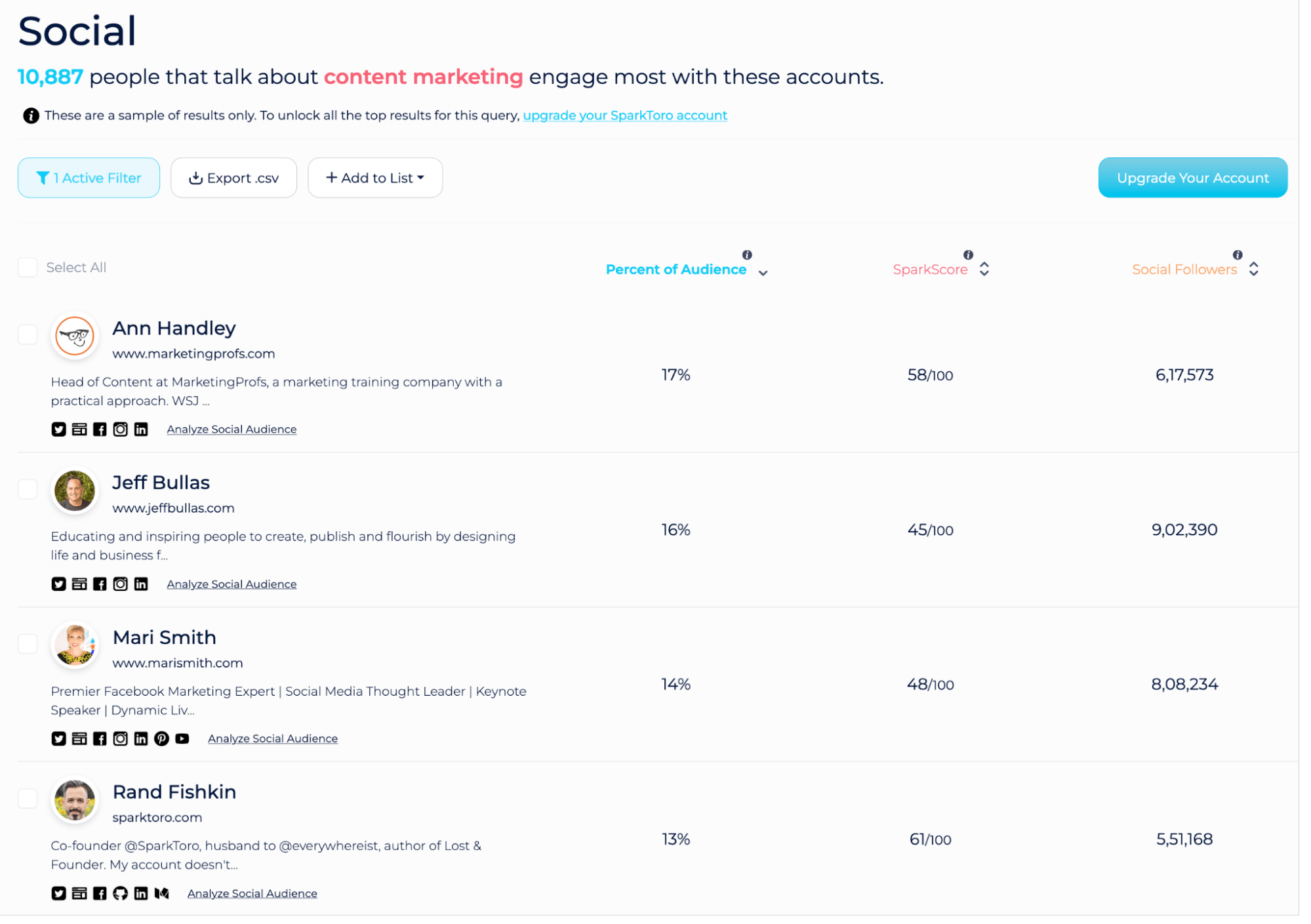
Another way to find SMEs is through Content Explorer. Here are the steps you can follow:
1. To start off, enter a topic in the search box and choose “In title.”
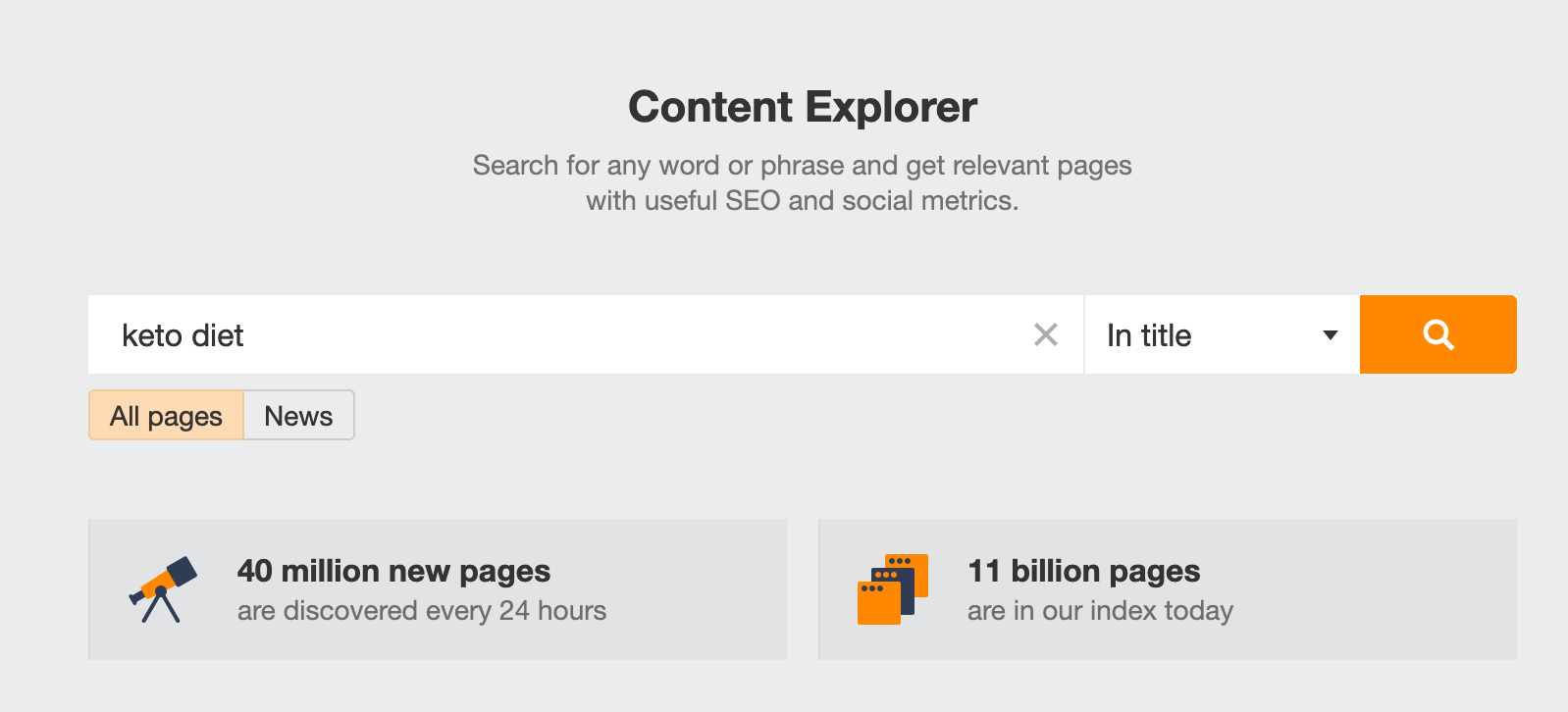
2. After that, you’ll see a list of the popular articles based on the whole historical database. You can further filter the results on the basis of platforms, publish dates, and more.
There’s also an option to sort the content based on page traffic, referring domains, and more.

3. The next step is to go through the author’s tab to find these experts.
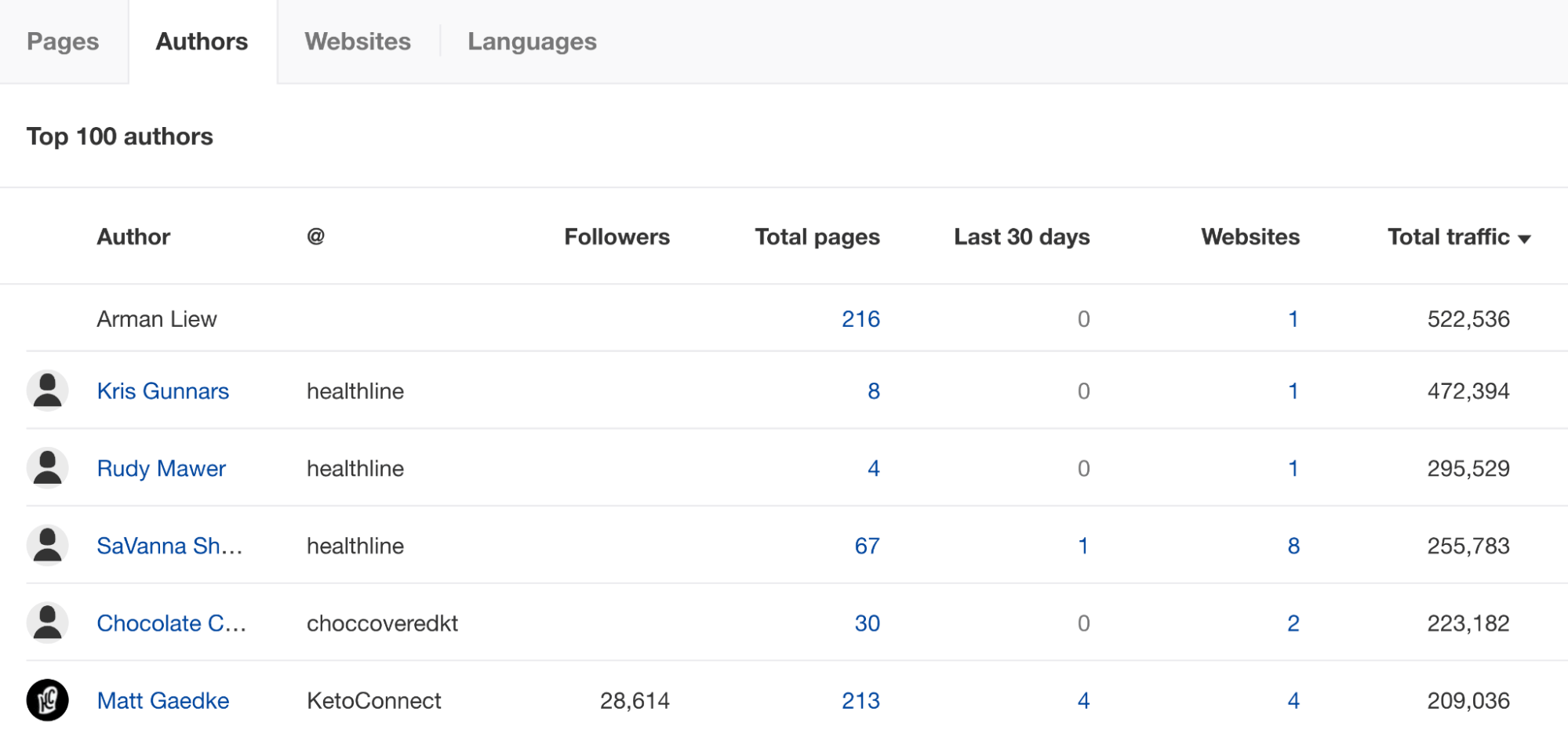
Alternatively, you can also go through the articles manually and discover top authors.
Once you’ve created the list, work on completing the contact information to reach out to those experts. During outreach, share how they would benefit from being featured in your article and how they would help improve your content.
It’s also helpful to draft a questionnaire for this type of outreach. Try to keep it short and focus only on questions where the answers can help you fill the gaps in the article. This will help you keep the conversation productive.
Social media is a great place for content research. By following the right people and pages, you can learn so much about your industry. This includes knowing the challenges your audience is facing, the latest industry trends, what tactics are working, and more.
All these posts and conversations help unlock a lot of insights. You can also always connect with relevant folks to dig deeper and understand their perspectives. Let’s look at the different platforms and how you can use them for your content research.
On Twitter, I’d recommend using its advanced search functionality to start your research. You can include some relevant keywords around your topic and hashtags and then filter the results by minimum engagement and date.
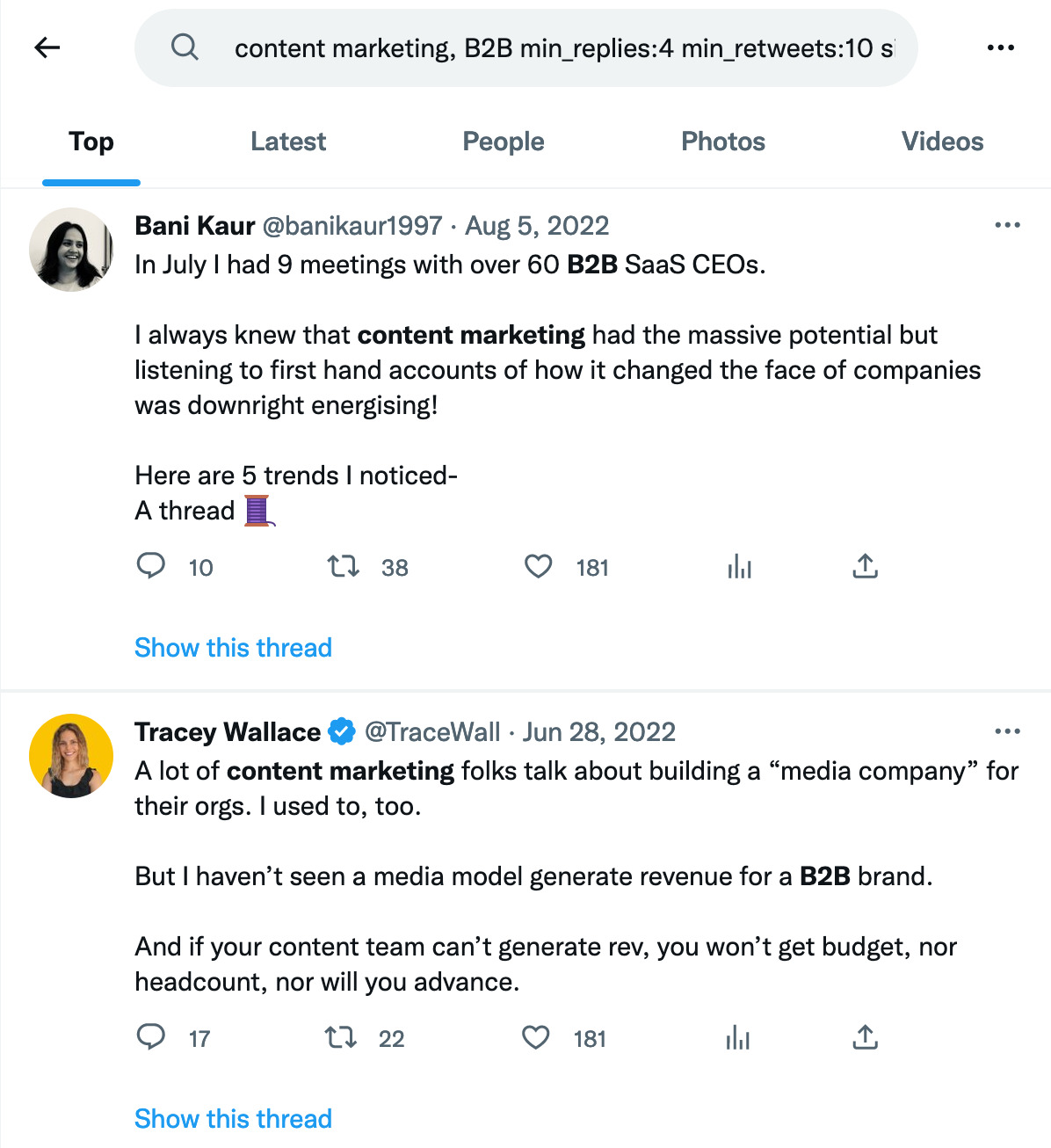
But keep in mind that, sometimes, the real valuable gems don’t get a lot of engagement and may be difficult to find.
Additionally, to follow the latest industry trends, you can create a list of influencers and pages in your niche on Twitter. This way, you can follow these folks closely, which may be otherwise hard to track in your regular feed.
Reddit is an amazing platform for content research because it’s hard to not find a subreddit for your niche. Start with a quick search and go through the conversations.
Alternatively, you can start a discussion by putting out a post on a relevant subreddit (like the example below). Just be mindful of the rules of each subreddit when posting.
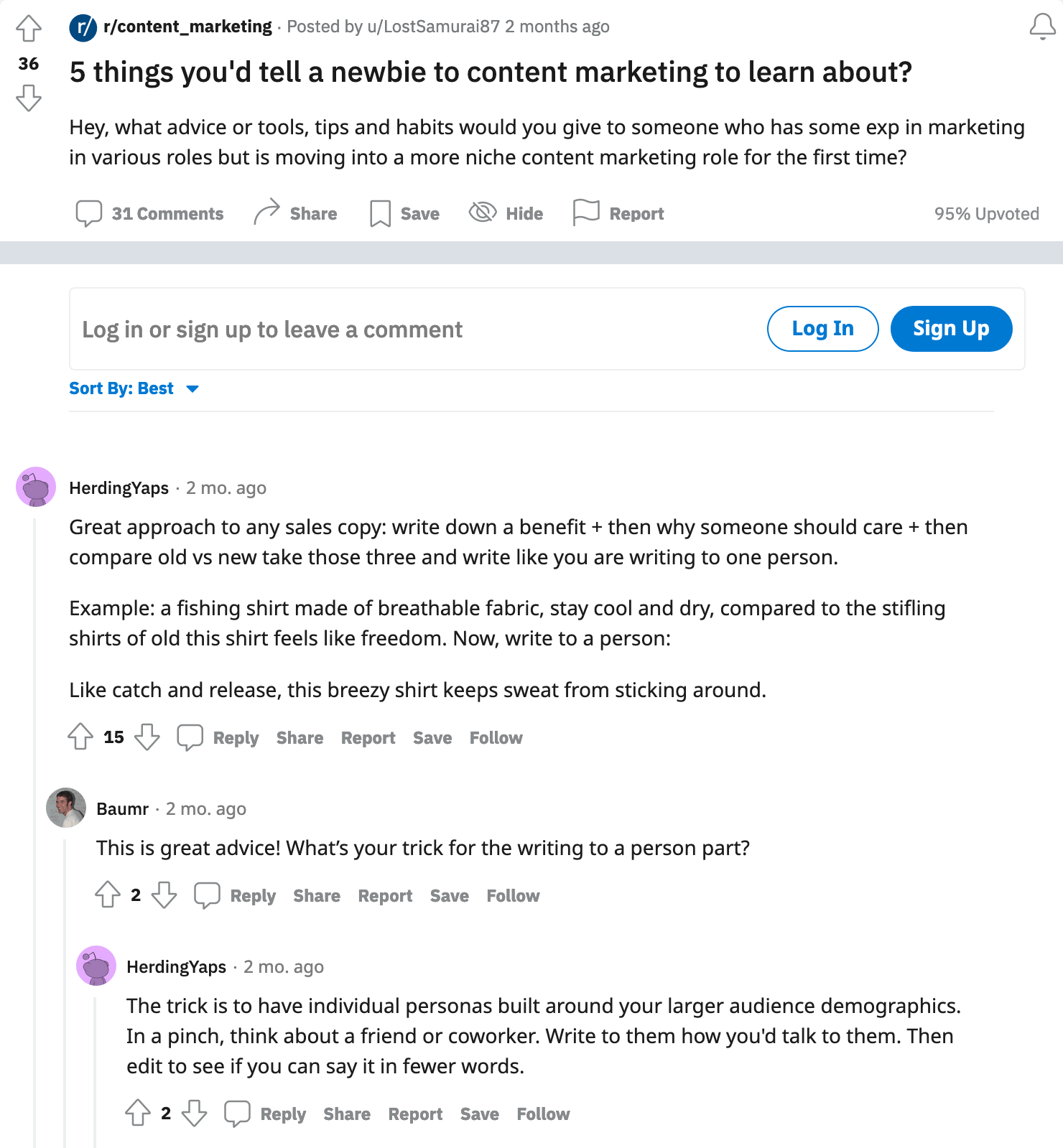
Partnering with an influencer or with brands you respect for a content piece can be a great way to produce high-quality content. There are multiple benefits of collaborative marketing, including:
- Access to data – You can get access to highly valuable first-party data that you can leverage in your content.
- Additional expertise – Collaborating with a brand/influencer in your niche may help you unlock key insights.
- Co-marketing opportunities – By partnering with a brand/influencer, you can attract a newer audience.
Ultimately, it helps you achieve a greater overall impact with your content piece.
Here’s an example of Ahrefs collaborating with Kontent (a headless CMS) for a webinar:

Ahrefs is the authority in SEO the Kontent team needs for this topic. Kontent’s audience consists of potential enterprise-level leads for Ahrefs, where 45 minutes of brand and product exposure have great value. It’s a win-win.
While access to third-party information is just a few clicks away, getting first-party information can be challenging. One quick way to get it is by running surveys. It can be as simple as putting out a poll on LinkedIn or Twitter. You can post it from your company page or your own profile. This completely depends on where you think you can get maximum responses.
If you follow Ahrefs’ CMO, Tim Soulo, on Twitter, you’ll know how much he leverages polls to ask questions for research:
Domain age is a (relatively significant) ranking factor in Google.
— Tim Soulo 🇺🇦 (@timsoulo) November 28, 2022
Similarly, you can run polls in communities and newsletters. Ahrefs has an active Facebook community, where it often runs polls for content and product research.

Alternatively, if you have the budget, you can leverage paid tools like Pollfish and SurveyMonkey. These tools help you run surveys on their platforms and get you responses. You create a target audience by defining parameters like location, interest, age, gender, etc. Running a paid survey is useful if you’re planning to create a data-backed report, white paper, or article.
No matter what you’re writing, if there’s a way you can support it with some data, then there’ll be nothing like it.
Articles contain limited information. And that’s why if you are looking to do extensive research around a topic, just going through blogs is not enough. You should read white papers and reports in your niche. Going through them will help you discover insights and data that you’ll rarely find outside.
For example, McKinsey & Company publishes some very detailed reports and white papers on different industries and their growth consistently. Similarly, companies like Deloitte, Forrester, and Statista are also active in publishing reports and white papers.
A few things to keep in mind are to:
- Try going through the most recent reports, especially when you want to analyze statistics.
- Trust only credible resources.
- Make a note of statistics and insights as soon as you discover them along with the source.
Google’s quality evaluator guidelines, for example, is a 176-page document that explains exactly how to evaluate a search result. Many SEOs use it to understand how Google works and to help webmasters understand what Google looks for in webpages. You’ll see it referenced in tons of SEO resources.
You’ll be surprised how much your readers can assist you with your content research. By understanding their challenges, aspirations, and goals, you can easily identify what to include in your article and what not to do. Moreover, you can identify new topics to write about.
Here are a few ways. You can:
- Put out a social media post from your business account asking readers what they want to know about a specific topic.
- Run reader surveys.
- Get feedback on your existing published article. For example, Ahrefs asks its readers to vote on how useful the article is by rating it out of 5. So if the rating for a particular content piece is poor, you can take another look and improve it.

Final thoughts
It’s clear that creating valuable and impactful content is impossible without content research. The time investment into content research will pay off in the long run.
Got questions? Ping me on Twitter.
SEO
Is It Alternatives You’re Looking For?

Whatever the reason, in this article, I’ll share some alternatives to HARO and a few extra ways to get expert quotes and backlinks for your website.
Disclaimer: I am not a PR expert. I did a bit of outreach a few years ago, but I have only been an occasional user of HARO in the past year or so.
So, rather than providing my opinion on the best alternatives to HARO, I thought it would be fun to ask users of the “new HARO” what they thought were the best alternatives.
I wanted to give the “new HARO”—Connectively—the benefit of the doubt.
Still, a few minutes after my pitch was accepted, I got two responses that appeared to be AI-generated from two “visionary directors,” both with “extensive experience.”
My experience of Connectively so far mirrored Josh’s experience of old HARO: The responses were most likely automated.
Although I was off to a bad start, looking through most of the responses afterward, these two were the only blatant automated pitches I could spot.
These responses weren’t included in my survey, and anyone who saw my pitch would have to copy and paste the survey link to complete it—increasing the chance of genuine human responses—hopefully.
So, without further ado, here are the results of the survey.
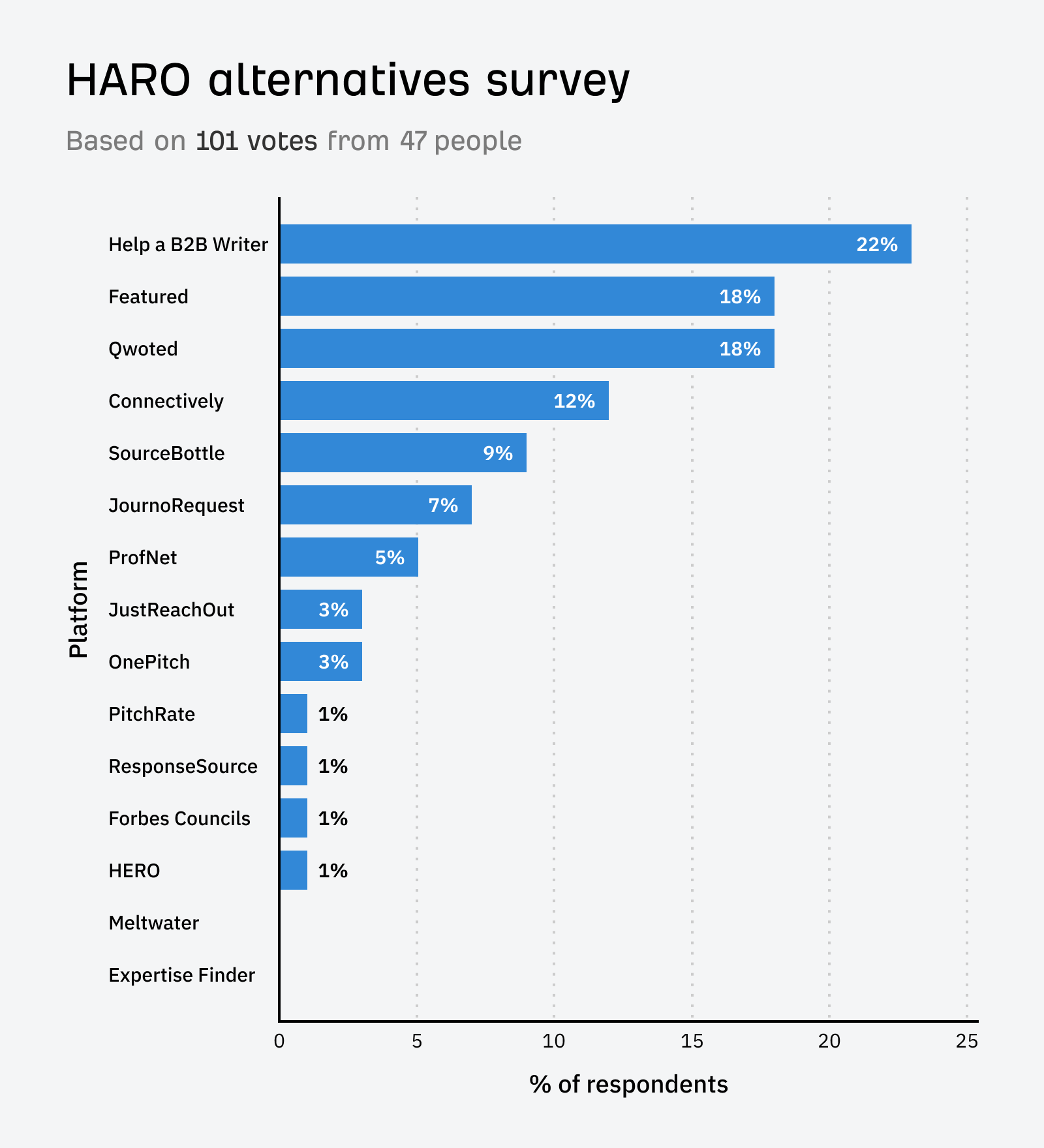

Sidenote.
The survey on Connectively ran for a week and received 101 votes. Respondents could vote for their top three HARO alternatives.
Price: Free.
Help a B2B Writer was the #1 alternative platform respondents recommended. In my survey it got 22% of the vote.
Help a B2B Writer is a platform run by Superpath that is similar to HARO but focused on connecting business-to-business (B2B) journalists with industry experts and sources for their stories.


Price: Free and paid plans. Paid plans start at $99 per month.
Coming in joint second place, Featured was popular, scoring 18% of the vote.
Featured connects journalists with experts and thought leaders. It allows experts to create profiles showcasing their expertise and helps journalists find suitable sources for their stories.


Price: Free and paid plans. Paid plans start at $99 per month.
Qwoted is another platform that I’ve heard talked about a lot. It came in joint second place, scoring 18% of the vote.
Qwoted matches journalists with expert sources, allowing them to collaborate on creating high-quality content. It streamlines the process of finding and connecting with relevant sources.


Price: Free for ten pitches per month
Despite being the “new HARO,” Connectively came 4th on my list, scoring 12% of the vote—surprisingly, it wasn’t even the top choice for most users on its own platform.
Connectively connects journalists with sources and experts. It helps journalists find relevant sources for their stories and allows experts to gain media exposure.
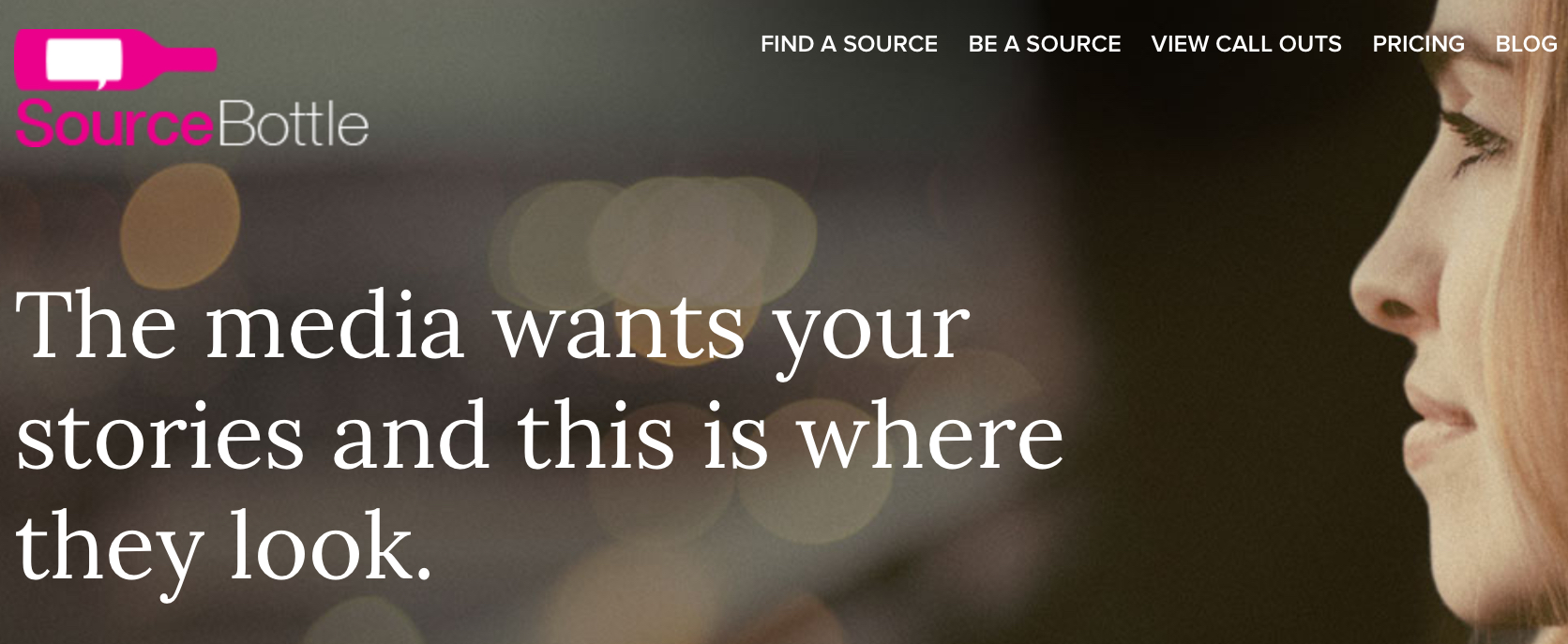

Price: Free and paid plans. Paid plans start at $5.95 per month.
SourceBottle is an online platform that connects journalists, bloggers, and media professionals with expert sources. It allows experts to pitch their ideas and insights to journalists looking for story sources. It scored 9% of the vote in my survey.


Price: Free.
JournoRequest is an X account that shares journalist requests for sources. UK-based journalists and experts often use it, but it can sometimes have international reach. It scored 7% of the vote in my survey.
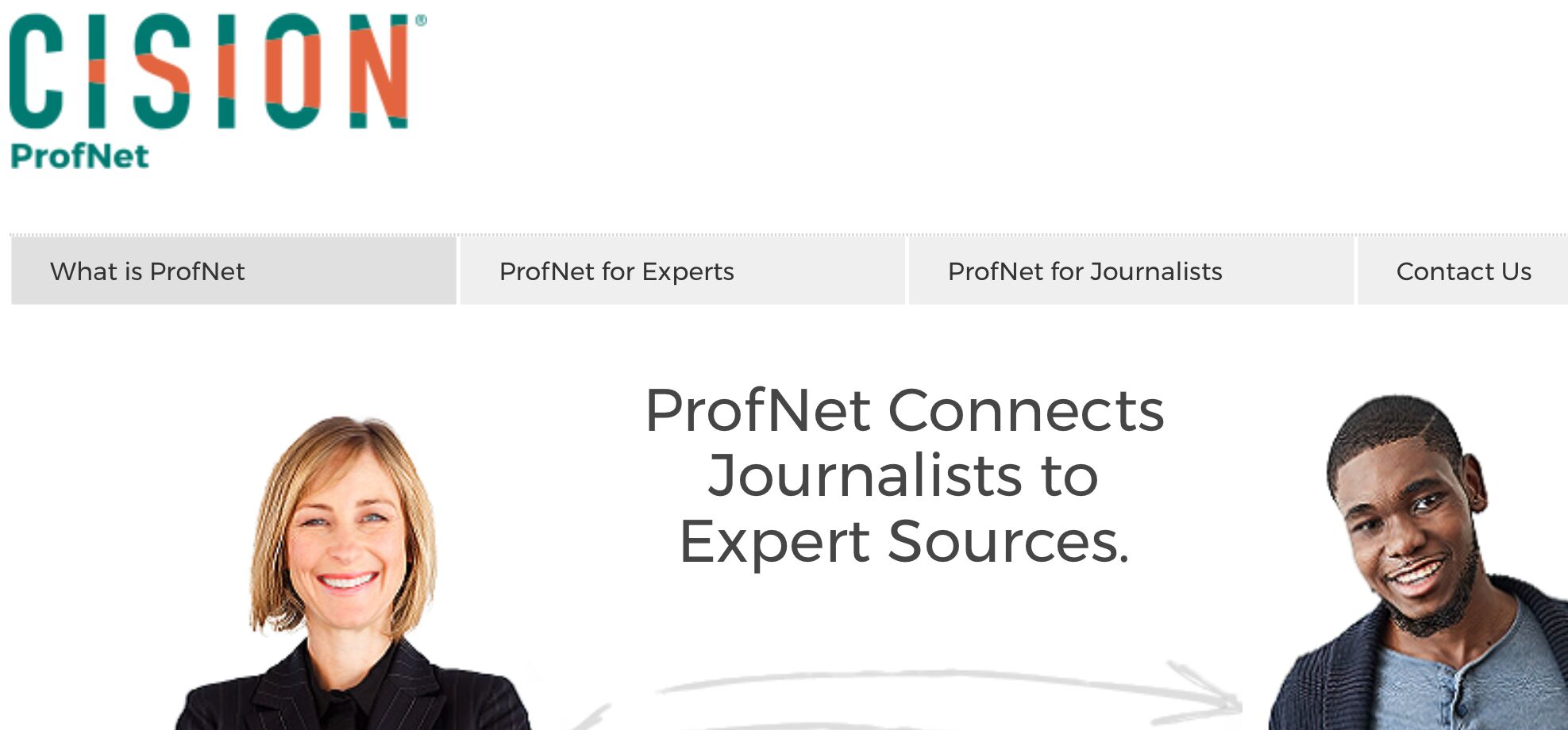

Price: Paid. Plans start at $1,150 per year.
ProfNet connects journalists to expert sources. It helps journalists find knowledgeable sources for their articles, interviews, and other media content. It helps subject matter experts gain media exposure and share their expertise. It scored 5% of the vote in my survey.


Price: 7-day free trial and paid plans. Paid plans start at $147 per month.
JustReachOut is a PR and influencer outreach platform that helps businesses find and connect with relevant journalists and influencers. It provides tools for personalized outreach and relationship management. It scored 3% of the vote in my survey.


Price: 14-day free trial and paid plans. Paid plans start at $50 per month.
OnePitch is a platform that simplifies the process of pitching story ideas to journalists. Businesses and PR professionals can create and send targeted pitches to relevant media outlets. It scored 3% of the vote in my survey.


Price: Free.
PitchRate is a free PR tool that connects journalists and highly rated experts. Useful for subject matter experts looking for free PR leads, media coverage, or publicity. Or journalists looking for credible sources. It scored 1% of the vote in my survey.
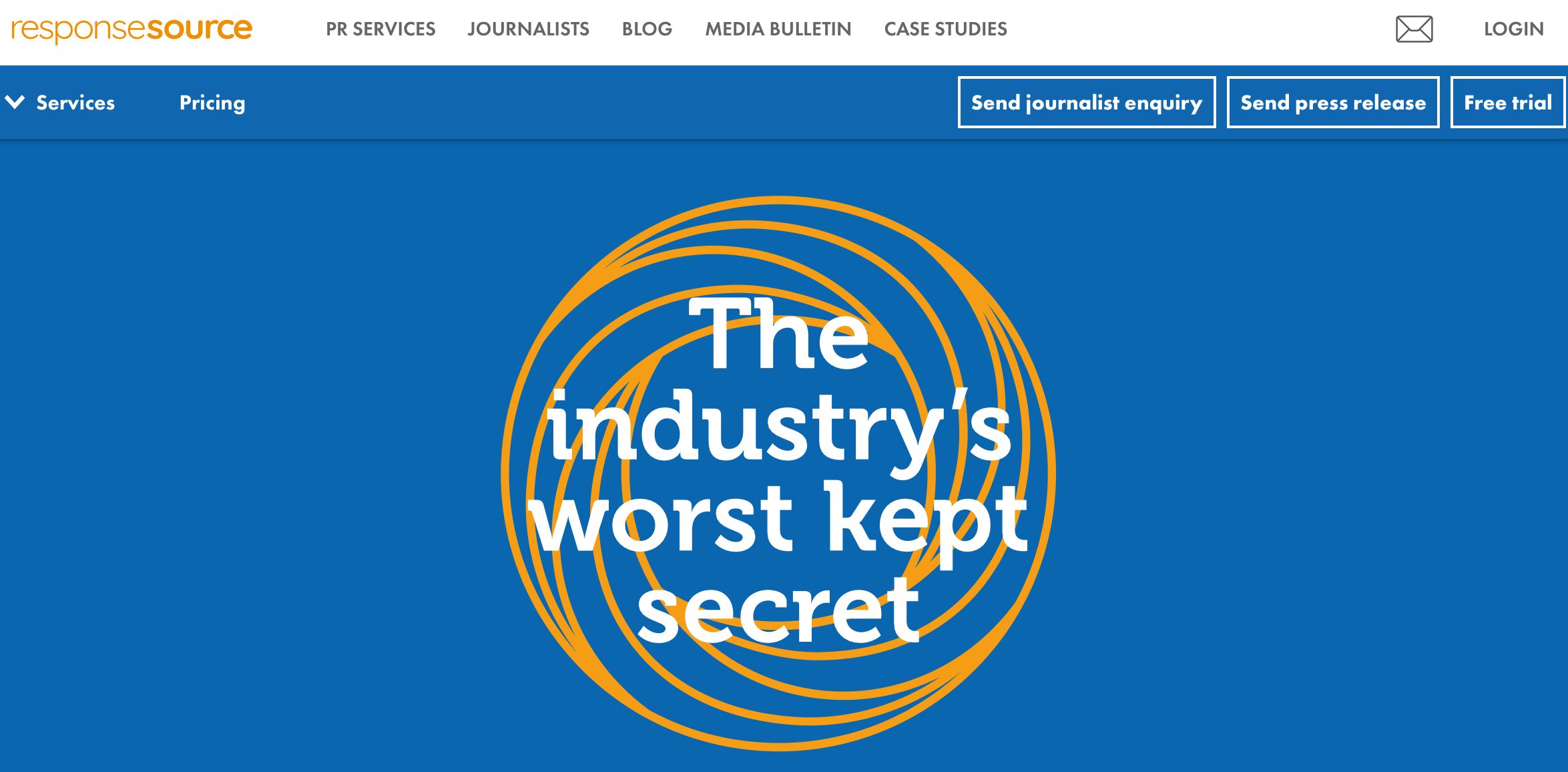

Price: Free and paid plans. Paid plans start at ~$105 per month.
A UK service that connects media professionals with expert sources, press releases, and PR contacts. It scored 1% of the vote in my survey.


Price: Invitation-only platform.
Forbes Councils is an invitation-only community for executives and entrepreneurs. Members can contribute expert insights and thought leadership content to Forbes.com and gain media exposure. It scored 1% of the vote in my survey.


Price: Free.
Yes, you read that right.
HERO was created by Peter Shankman, the original creator of HARO, who said the platform will always be free. It scored 1% of the vote in my survey.
Peter set up the platform after receiving over 2,000 emails asking him to build a new version of HARO.
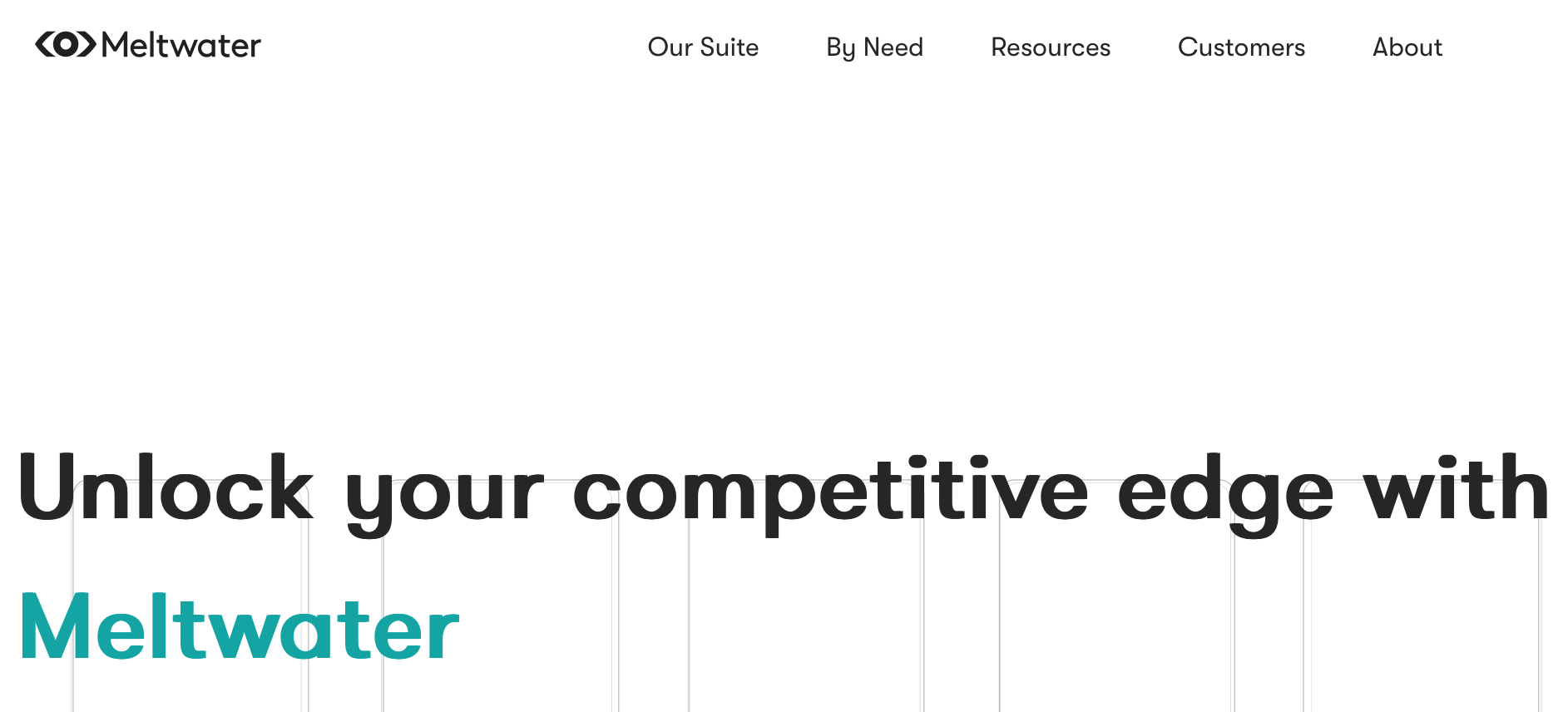

Price: Paid. Sign up for details.
Meltwater received no votes in my survey, but I included it because I’d seen it shared on social media as a paid alternative to HARO.
It’s a media intelligence and social media monitoring platform. It provides tools for tracking media coverage, analyzing sentiment, and identifying influencers and journalists for outreach.


Price: Free.
Expertise Finder also received no votes in my survey, but it was included as I saw it had been recommended as an HARO alternative on LinkedIn. It’s a platform that helps journalists find and connect with expert sources from universities.
HARO had a dual purpose for SEOs: it was a place to acquire links, but it also was a place to get expert quotes on topics for your next article.
Here are a few more free methods outside the platforms we’ve covered that can help you get expert quotes and links.
We’ve already seen that JournoRequest is a popular X account that shares journalist requests for sources.
But you can also follow hashtags on X to access even more opportunities.
Here are my favorite hashtags to follow:
I used to track the #journorequest hashtag to find opportunities for my clients when I worked agency-side, so I know it can work well for quotes and link acquisition.
Here are two opportunities I found just checking the #journorequest hashtag:


Here’s another example from the Telegraph—a DR 92 website:


Certain types of content are more likely to be shared by journalists and PRs than others.
One of these types of content is statistics-based content. The reason? Journalists often use statistics to support their points.
Once they have included your statistic in their post, they often add a backlink back to your post.
We tested this with our SEO statistics post, and as you can see, it still ranks number one in Google.


Another method is to use the Linking authors report in Ahrefs’ Site Explorer. This report shows the authors’ names who link to any website you enter.
You can see which authors link to their site by entering your competitor’s domain. Some of these authors may represent outreach opportunities for your website as well.
- Head to Site Explorer, click on Linking authors
- Type in your competitor’s URL
- Contact any authors that you think may be interested in your website and its content
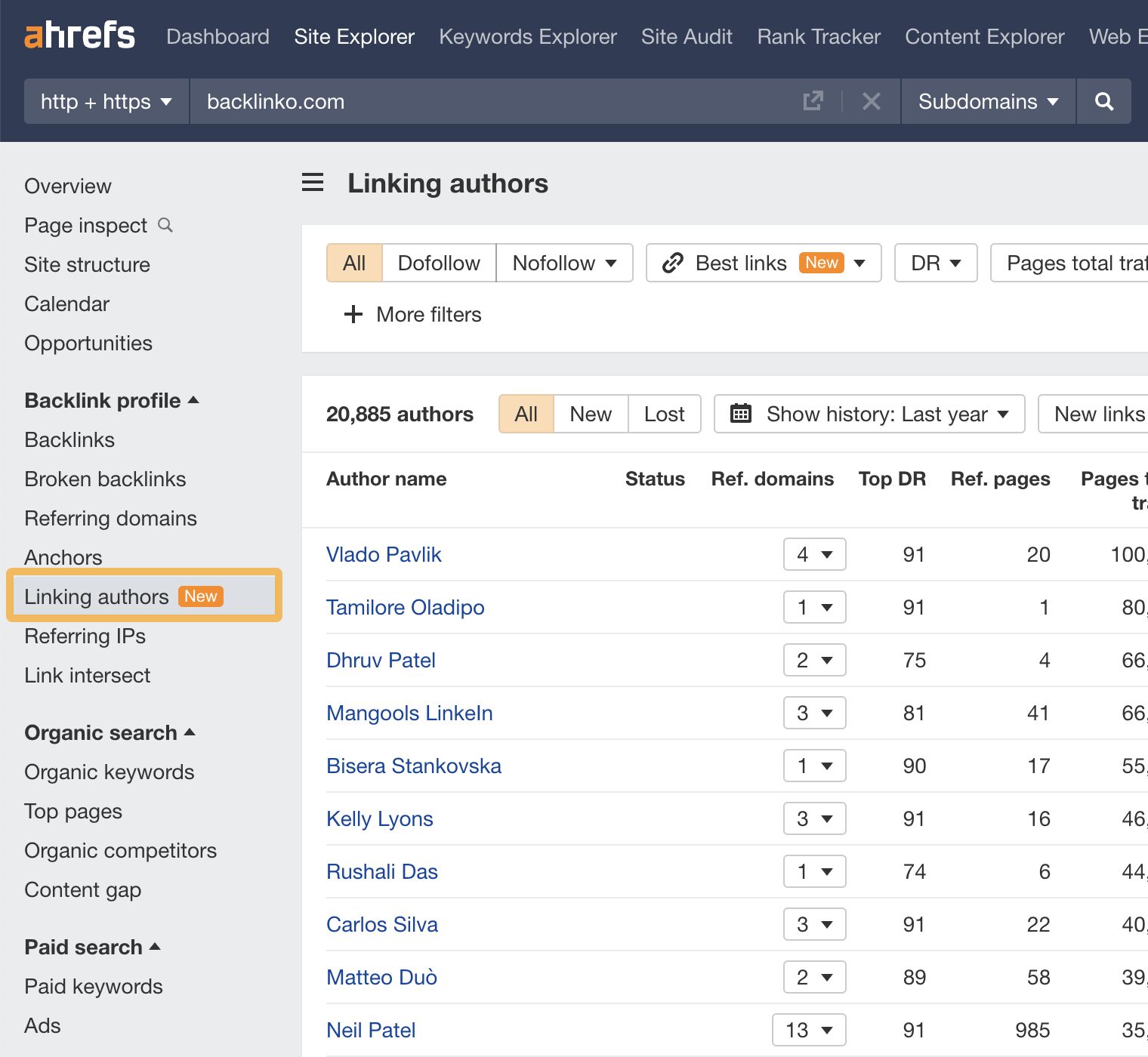

Tip
If you download your website’s linking authors and your competitors into a spreadsheet and put them into separate tabs, you can compare the lists to see which authors are only linking to your competitor’s website.
When I was about to wrap up this article, I was contacted by Greg Heilers of Jolly SEO on LinkedIn.
He said he’d sent 200,000+ pitches over the years and wanted to share the results with me.
These are his top three platforms over the last 1,000 pitches he sent. Interestingly, we can see that it’s similar to my much smaller-scale survey.


Hopefully, the data here speaks for itself. The high-quality links and traffic from HARO alternatives is considerable.
This research shows that Featured gained the most link placements in this campaign.
We have compiled some helpful content related to link building that you can get your teeth into. These hand-picked guides will take you from beginner to expert in no time.
Here are my favorite resources on this topic:
Final thoughts
There are many options for sourcing expert quotes and getting links for your next marketing campaigns. HARO may be dead, but its legacy lives on.
My highly unscientific survey suggests that most “new HARO” users liked Help a B2B Writer the most, but for HARO purists, there really is only one choice—HERO.
Give your favorites from this list a whirl, and let me know if you have any success. Got more questions? Ping me on X. 🙂
SEO
OpenAI To Show Content & Links In Response To Queries
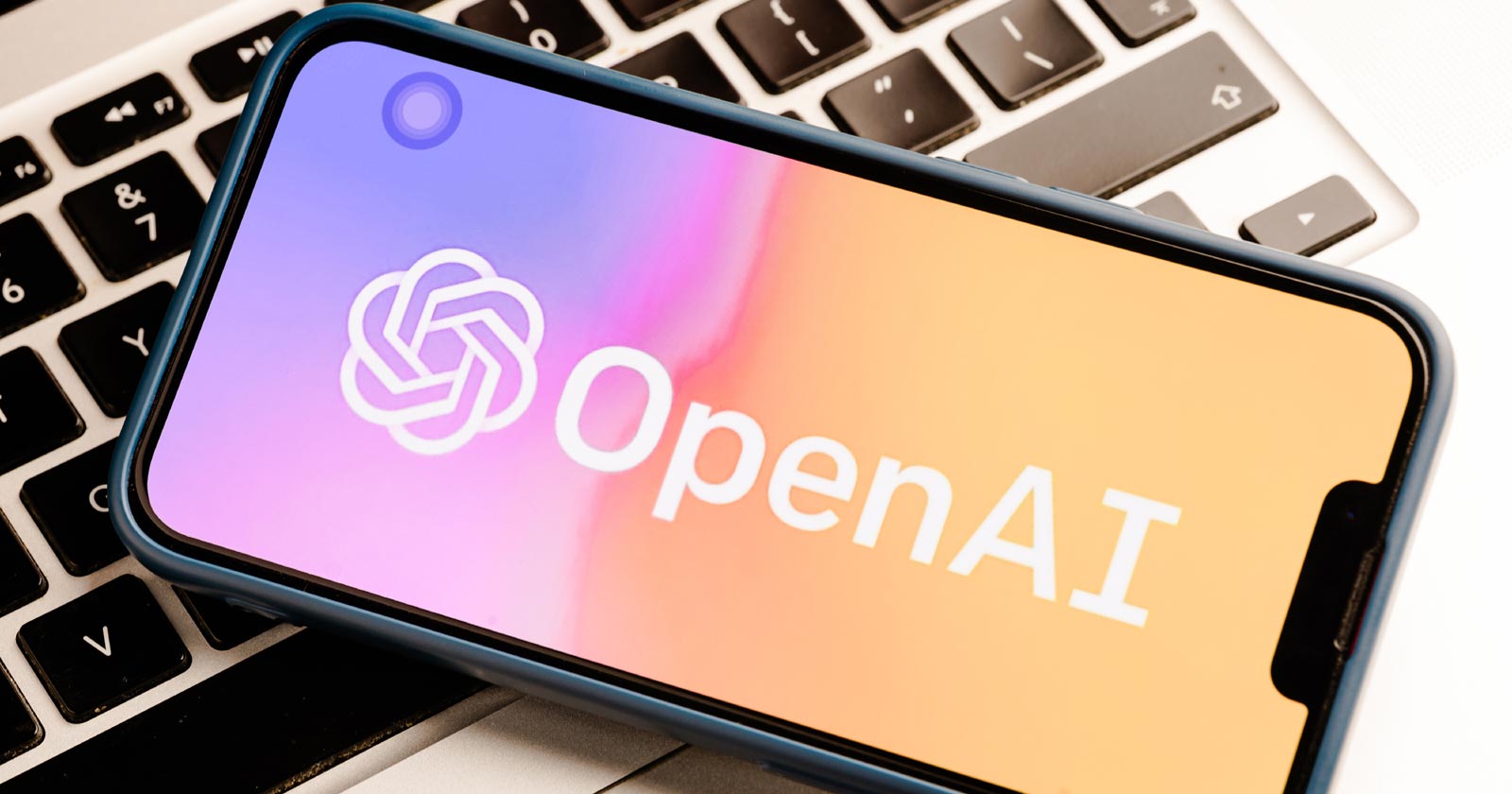
OpenAI content deal will enhance ChatGPT with the ability to show real-time content with links in response to queries. OpenAI quietly took steps to gaining more search engine type functionality as part of a content licensing deal that may have positive implications for publishers and SEO.
Content Licensing Deal
OpenAI agreed to content licensing with the Financial Times, a global news organization with offices in London, New York, across continental Europe and Asia.
Content licensing deals between AI organizations and publishers are generally about getting access to high quality training data. The training data is then used by language models to learn connections between words and concepts. This deal goes far beyond that use.
ChatGPT Will Show Direct Quotes With Attribution
What makes this content licensing deal between The Financial Times and OpenAI is that there is a reference to giving attribution to content within ChatGPT.
The announced licensing deal explicitly mentions the use of the licensed content so that ChatGPT could directly quote it and provide links to the licensed content.
Further, the licensing deal is intended to help improve ChatGPT’s “usefulness”, which is vague and can mean many things, but it takes on a slightly different meaning when used in the context of attributed answers.
The Financial Times agreement states that the licensing deal is for use in ChatGPT when it provides “attributed content” which is content with an attribution, commonly a link to where the content appeared.
This is the part of the announcement that references attributed content:
“The Financial Times today announced a strategic partnership and licensing agreement with OpenAI, a leader in artificial intelligence research and deployment, to enhance ChatGPT with attributed content, help improve its models’ usefulness by incorporating FT journalism, and collaborate on developing new AI products and features for FT readers. “
And this is the part of the announcement that mentions ChatGPT offering users attributed quotes and links:
“Through the partnership, ChatGPT users will be able to see select attributed summaries, quotes and links to FT journalism in response to relevant queries.”
The Financial Times Group CEO was even more explicit about OpenAI’s intention to show content and links in ChatGPT:
“This is an important agreement in a number of respects,” said FT Group CEO John Ridding. “It recognises the value of our award-winning journalism and will give us early insights into how content is surfaced through AI. …this partnership will help keep us at the forefront of developments in how people access and use information.
OpenAI understands the importance of transparency, attribution, and compensation…”
Brad Lightcap, COO of OpenAI directly referenced showing real-time news content in ChatGPT but more important he referenced OpenAI exploring new ways to show content to its user base.
Lastly, the COO stated that they embraced disruption, which means innovation that creates a new industry or paradigm, usually at the expense of an older one, like search engines.
Lightcap is quoted:
“We have always embraced new technologies and disruption, and we’ll continue to operate with both curiosity and vigilance as we navigate this next wave of change.”
Showing direct quotes of Financial Times content with links to that content is very similar to how search engines work. This is a big change to how ChatGPT works and could be a sign of where ChatGPT is going in the future, a functionality that incorporates online content with links to that content.
Something Else That Is Possibly Related
Someone on Twitter recently noticed a change that is related to “search” in relation to ChatGPT.
This change involves an SSL security certificate that was added for a subdomain of ChatGPT.com. ChatGPT.com is a domain name that was snapped up by someone to capitalize on the 2022 announcement of ChatGPT by OpenAI. OpenAI eventually acquired the domain and it’s been redirecting to ChatGPT.
The change that was noticed is to the subdomain: search.chatgpt.com.
This is a screenshot of the tweet:
Big News For SEO and Publishers
This is significant news for publishers and search marketers ChatGPT will become a source of valuable traffic if OpenAI takes ChatGPT in the direction of providing attributed summaries and direct quotes.
How Can Publishers Get Traffic From ChatGPT?
Questions remain about attributed quotes with links in response to relevant queries. Here are X unknowns about ChatGPT attributed links.
- Does this mean that only licensed content will be shown and linked to in ChatGPT?
- Will ChatGPT incorporate and use most web data without licensing deals in the same way that search engines do?
- OpenAI may incorporate an Opt-In model where publishers can use a notation in Robots.txt or in meta data to opt-in to receiving traffic from ChatGPT.
- Would you opt into receiving traffic from ChatGPT in exchange for allowing your content to be used for training?
- How would SEOs and publisher’s equation on ChatGPT change if their competitors are all receiving traffic from ChatGPT?
Read the original announcement:
Financial Times announces strategic partnership with OpenAI
Featured Image by Shutterstock/Photo For Everything
SEO
Google’s John Mueller On Website Recovery After Core Updates
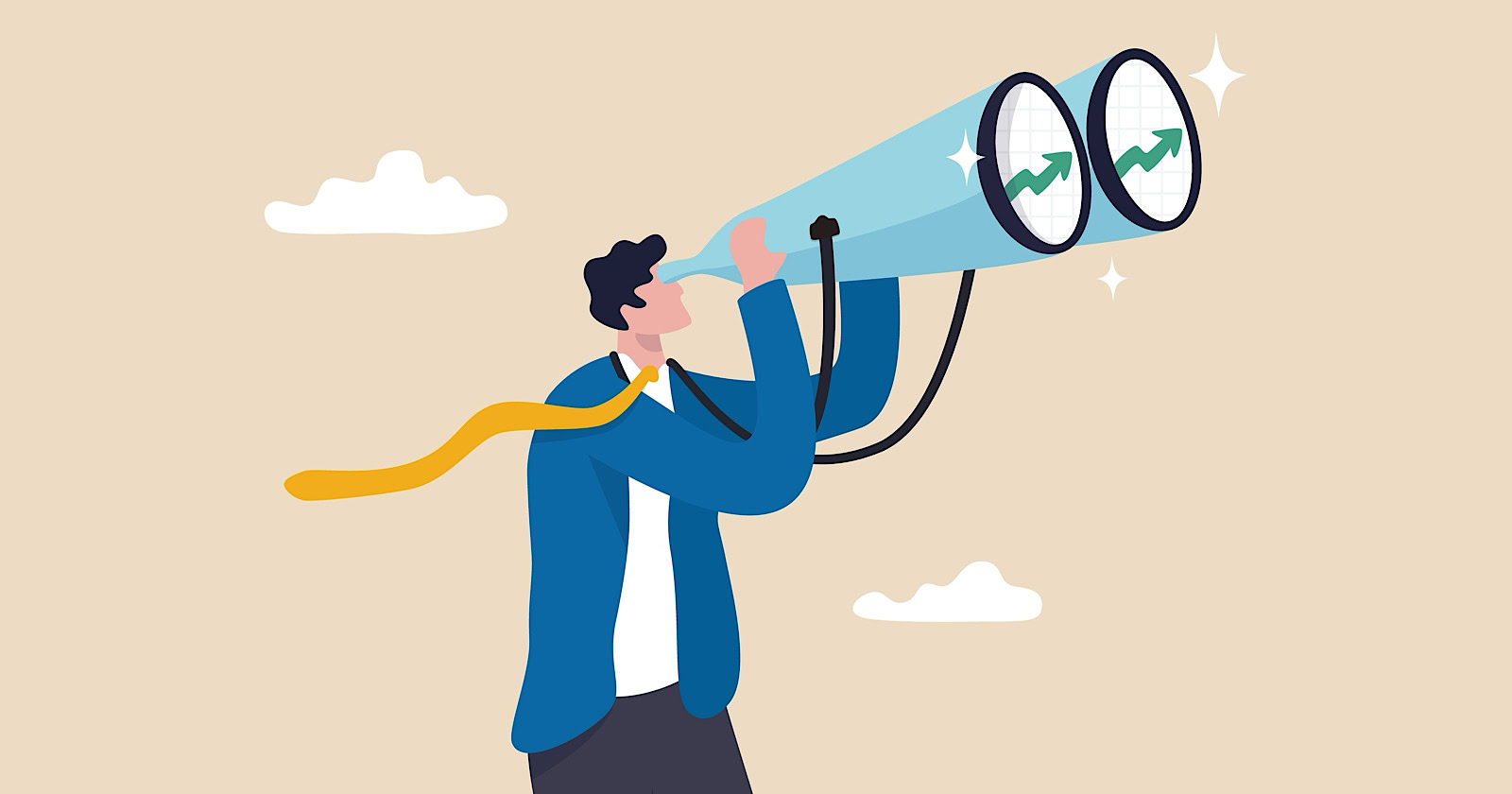
John Mueller, a Google Search Advocate, provided guidance this week regarding the path forward for websites impacted by recent search algorithm updates.
The discussion started on X (formerly Twitter) by SEO professional Thomas Jepsen.
Jepsen tagged Mueller, asking:
“Google has previously said Google doesn’t hold a grudge and sites will recover once issues have been solved. Is that still the case after HCU?”
Mueller’s response offered hope to site owners while being realistic about the challenges ahead.
Addressing Recovery Timelines
Mueller affirmed Google’s stance on not holding grudges, stating, “That’s still the case.”
However, he acknowledged the complexity of rankings, saying:
“…some things take much longer to be reassessed (sometimes months, at the moment), and some bigger effects require another update cycle.”
That’s still the case. That said, some things take much longer to be reassessed (sometimes months, at the moment), and some bigger effects require another update cycle. https://t.co/WDy7Q4dpzb has some more.
— John 🧀 … 🧀 (@JohnMu) April 29, 2024
Mueller pointed to a Google help document explaining the nuances. The document reads:
“Broad core updates tend to happen every few months. Content that was impacted in Search or Discover by one might not recover—assuming improvements have been made—until the next broad core update is released.
Do keep in mind that improvements made by site owners aren’t a guarantee of recovery, nor do pages have any static or guaranteed position in our search results. If there’s more deserving content, that will continue to rank well with our systems.”
The Comments Sparking Debate
Jepsen probed further, asking, “Is a core update what’s needed for HCU-affected sites to recover (assuming they’ve fixed their issues)?”
Mueller’s response highlighted how situations can differ:
“It depends on the situation… I realize there’s a big space between the situations, but generalizing doesn’t help. Sometimes it takes a lot of work on the site, a long time, and an update.”
It depends on the situation. https://t.co/F9s3Hli9t7 and https://t.co/pLdm29PjPD has some on that. I realize there’s a big space between the situations, but generalizing doesn’t help. Sometimes it takes a lot of work on the site, a long time, and an update.
— John 🧀 … 🧀 (@JohnMu) April 29, 2024
The thread grew as user @selectgame raised concerns about Google Discover traffic, to which Mueller replied:
“Google Discover is affected by core updates as well as other parts of Search (and there are more policies that apply to Discover).”
Google Discover is affected by core updates as well as other parts of Search (and there are more policies that apply to Discover). If you’re seeing these changes when a core update rolled out, that might be what you’re seeing.
— John 🧀 … 🧀 (@JohnMu) April 29, 2024
Growing Frustrations
Prominent industry figure Lily Ray voiced mounting frustrations, stating,
“…many HCU-affected websites – which have been making all kinds of improvements over the last 7 months – have only seen further declines with the March Core Update.
I have seen some sites lose 90% or more of their SEO visibility since the HCU, with the last few weeks being the nail in the coffin, despite making significant improvements.”
Ray continued:
“And in my professional opinion, many of these sites did not deserve anywhere near that level of impact, especially the further declines over the past month.”
Mueller hasn’t responded to Ray’s tweet at this time.
John, any chance you can comment on the fact that many HCU-affected websites – which have been making all kinds of improvements over the last 7 months – have only seen further declines with the March Core Update?
I have seen some sites lose 90% or more of their SEO visibility… https://t.co/lvYRAScRQQ
— Lily Ray 😏 (@lilyraynyc) April 29, 2024
Looking Ahead
As the search community awaits Google’s next moves, the path to recovery appears arduous for many impacted by recent algorithm reassessments of “Helpful Content.”
Site improvements don’t guarantee immediate recovery, so publishers face an uphill battle guided only by Google’s ambiguous public advice.
Why SEJ Cares
The March 2024 core update has proven disastrous for many websites, with severe traffic losses persisting even after sites try to improve low-quality content, address technical issues, and realign with Google’s guidelines.
Having clear, actionable guidance from Google on recovering from core update updates is invaluable.
As evidenced by the frustrations expressed, the current communications leave much to be desired regarding transparency and defining a straightforward recovery path.
How This Can Help You
While Mueller’s comments provide some insights, the key takeaways are:
- Regaining previous rankings after an algorithm hit is possible if sufficient content/site quality improvements are made.
- Recovery timelines can vary significantly and may require a future core algorithm update.
- Even with enhancements, recovery isn’t guaranteed as rankings depend on the overall pool of competing content.
The path is undoubtedly challenging, but Mueller’s comments underscore that perseverance with substantial site improvements can eventually pay off.
FAQ
Can SEO professionals predict recovery time for a website hit by core updates?
SEO professionals can’t pinpoint when a site will recover after a core Google algorithm update.
Reasons for this include:
- Google releases core updates every few months, so sites may need to wait for the next one.
- It can take months for Google to reassess and adjust rankings.
- How competitive the query is also impacts if and when a site recovers.
Does making site improvements after a core update ensure recovery in rankings and visibility?
After making improvements following a Google algorithm update, regaining your previous rankings isn’t guaranteed.
Reasons why include:
- Your impacted content may not recover until the next core update, provided you’ve implemented enough site improvements.
- Google’s search results are dynamic, and rankings can fluctuate based on the quality of competitor content.
- There’s no fixed or guaranteed position in Google’s search results.
What is the relationship between Google Discover traffic and core search updates?
Google’s core algorithm updates that impact regular search results also affect Google Discover.
However, Google Discover has additional specific policies that determine what content appears there.
This means:
- Improving your content and website quality can boost your visibility on Google Discover, just like regular searches.
- You may see changes in your Discover traffic when Google rolls out core updates.
- Your SEO and content strategy should account for potential impacts on regular searches and Google Discover.
Featured Image: eamesBot/Shutterstock
-

 MARKETING7 days ago
MARKETING7 days agoEffective Communication in Business as a Crisis Management Strategy
-

 SEARCHENGINES7 days ago
SEARCHENGINES7 days agoGoogle Won’t Change The 301 Signals For Ranking & SEO
-

 SEO6 days ago
SEO6 days agobrightonSEO Live Blog
-

 PPC7 days ago
PPC7 days ago9 Ecommerce Trends to Boost Your Business in 2024
-

 SEO5 days ago
SEO5 days agoGoogle March 2024 Core Update Officially Completed A Week Ago
-

 WORDPRESS5 days ago
WORDPRESS5 days ago9 Best WooCommerce Multi Vendor Plugins (Compared)
-
SEARCHENGINES6 days ago
Daily Search Forum Recap: April 25, 2024
-

 WORDPRESS6 days ago
WORDPRESS6 days agoYour New Favorite Way to Develop WordPress Locally – WordPress.com News














![The Current State of Google’s Search Generative Experience [What It Means for SEO in 2024] person typing on laptop with](https://articles.entireweb.com/wp-content/uploads/2024/04/The-Current-State-of-Googles-Search-Generative-Experience-What-It.webp-80x80.webp)

You must be logged in to post a comment Login